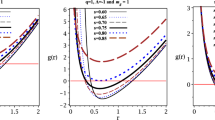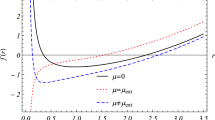Abstract
The gravitational collapse in generalized Vaidya space-time is considered. It is known that the end state of gravitational collapse, as to whether a black hole or a naked singularity is formed, depends on the mass function M(v, r). Here we give conditions for the mass function which correspond to the equation of the state P = αρ. where α ∈ (0, 1/3], and according to these conditions we obtain either a black hole or a naked singularity as the end state of gravitational collapse. We also give the conditions for the mass function under which the singularity is gravitationally strong. We present simple examples showing when the result of gravitational collapse is a naked singularity and when this singularity is strong.
Similar content being viewed by others
References
A. A. Grib, Yu. V. Pavlov, and V. D. Vertogradov, “Geodesics with negative energy in the ergosphere of rotating black holes,” Mod. Phys. Lett. A 29, 14501–14510 (2014).
V. D. Vertogradov, “Geodesicswith negative energy in the ergosphere of rotating black holes,” Grav. Cosmol. 21, 171–174 (2015).
A. Papapetrou, in A Random Walk in Relativity and Cosmology (Wiley Eastern, New Delhi, 1985).
P. S. Joshi, Gravitational Collapse and Space-Time Singularities (Cambridge University Press, 2007), p. 273.
M. D. Mkenyeley, R. Goswami, and S. D. Maharaj, “Gravitational collapse of generalized Vaidya spacetime,” Arxiv: 1407.4309.
S. M. Wagh and S. D. Maharaj, “Naked singularity of the Vaidya-de Sitter space-time and the cosmic censorship hypothesis,” gr-qc/9903083.
B. C. Nolan, Phys. Rev. D 60, 024014 (1999).
A. Wang and Yu. Wu, “GeneralizedVaidya solutions,” gr-qc/9803038.
F. J. Tipler, Phys. Lett. A 64, 8 (1977).
A. A. Grib and Yu. V. Pavlov, “Are black holes totally black?”, Grav. Cosmol. 21, 13–18 (2015).
Author information
Authors and Affiliations
Corresponding author
Additional information
This issue of the journal is dedicated to the centenary of Prof. K.P. Staniukovich.
Rights and permissions
About this article
Cite this article
Vertogradov, V.D. Naked singularity formation in generalized Vaidya space-time. Gravit. Cosmol. 22, 220–223 (2016). https://doi.org/10.1134/S020228931602016X
Received:
Accepted:
Published:
Issue Date:
DOI: https://doi.org/10.1134/S020228931602016X




